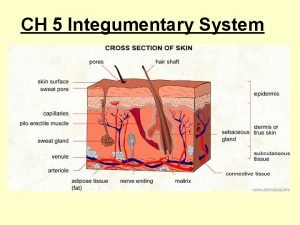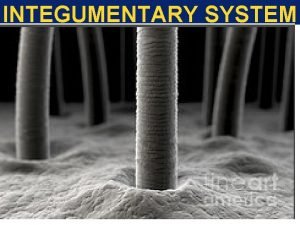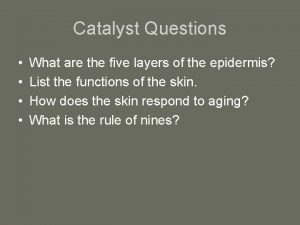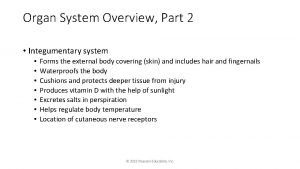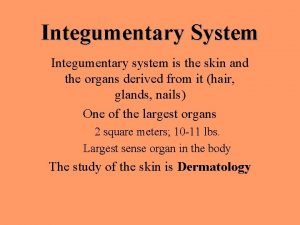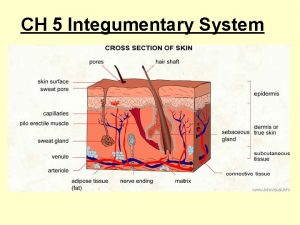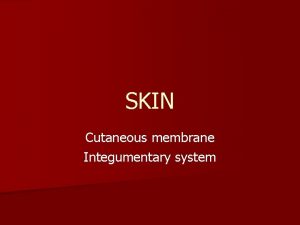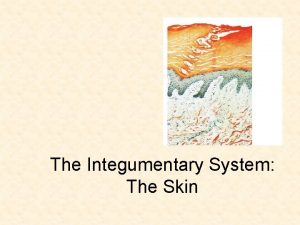INTEGUMENTARY SYSTEM Introduction to the SKIN Integumentary System





















- Slides: 21

INTEGUMENTARY SYSTEM

Introduction to the SKIN! �Integumentary System �Skin (aka- cutaneous membrane) �Nails �Hair Follicles �Skin Glands �The skin is the largest organ by weight �Functions: �Protective covering �Slows water loss �Regulates body temperature �Houses sensory receptors �Excretes small amounts of waste �Helps in vitamin D formation

Tissues of the Skin- Into to Layers � 2 distinct layers �Epidermis � Outer layer � Stratified squamous epithelium �Dermis � Inner layer � Connective tissue � Smooth muscle tissue � Nervous tissue � Blood �Layers are separated by a basement membrane

Tissues of the Skin- Hypodermis �Subcutaneous layer �Aka- hypodermis �Not part of the skin �Areolar and adipose tissues �Binds skin to underlying organs �Helps insulate �Contains blood vessels that supply the skin �The dermis and hypodermis lack a sharp boundary


Tissues of the Skin- Injections �Intradermal injections �Injected into the skin �Subcutaneous injections �Injected into the hypodermis �Administered through a hollow needle �Also called hypodermic injections �Transdermal patches �Drug passes into the epidermis through a permeable membrane �Motion sickness, chest pain, blood pressure, smoking cessation

The Epidermis- Characteristics and Functions �Lacks blood vessels �Thickest on palms and soles (0. 0 -1. 4 mm) �Other body regions average 0. 07 -0. 12 mm �Production of new epidermal cells balances loss of dead cells in healthy skin �Skin does not completely wear away �Cell division increases where skin is rubbed/pressed regularly � Leads to calluses and corns �Protective Functions �Shields against water loss �Prevents injury �Protects against harmful chemicals �Keeps out pathogens

The Epidermis-Layers � 4 main layers: �Stratum corneum � Outermost layer � Keratinized, dead epithelial cells � Keratinization- hardening of cells, waterproof keratin proteins made and stored in the cells �Stratum granulosum �Strantum spinosum �Stratum basale � Deepest layer � Able to divide and grown � Receive nutrients from dermis � Contains melanocytes

The Epidermis- Pigmentation �The epidermis contains melanocytes �Produce the pigment melanin �Found in the stratum basale �Melanin �Provides skin color �Absorbs UV radiation

�Effect of Environmental Factors �Sunlight, UV light, X rays � Rapidly darken melanin � Stimulate melanocytes to produce more pigment � Pigment is transferred to nearby cells �Effect of Blood �Well oxygenated blood is bright red � Light-complexioned people may appear pink �Dilated vessels redden the skin � Overheated, embarrassed, under the influence of alcohol �Constriction of vesssel cause loss of color � Low body temperature, frightened/anxious person

�Human Skin Color �Determined by heredity and environmental & physiological factors �All people have ~same number of melanocytes �Differences in skin color result from different amounts of melanin produced � Controlled by several genes � More melanin = darker skin

The Dermis- General Characteristics �The boundary between the epidermis and dermis is uneven �Dermal papillae extend from dermis into ridges of the epidermis �Increases surface area �Most abundant in hands and feet �Form fingerprints � Genes determine general patterns � Fetal movement forms distinct characteristics �The dermis binds epidermis to underlying tissues �Thickness ranges from 0. 5 mm to 3. 0 mm

The Dermis- Layers �Papillary Layer �Upper layer �Areolar connective tissue �Reticular Layer �Lower layer �Dense irregular connective tissue �Give skin toughness and elasticity

The Dermis- Additional Components �Smooth muscle fibers �Can wrinkle the skin (testes) �Associated with hair follicles and glands �Skeletal muscle fibers �Voluntary movements (facial expressions)

�Nerve cells �Carry impulses to dermal muscles and glands �Carry sensory impulses away from sensory receptors � Lamellated corpuscles � In deep dermis � Respond to heavy pressure � Tactile corpuscles � In upper dermis � Sense light touch and texture �Accessory Structures (blood, hair follicles, glands)

Accessory Structures of the Skin. Nails �Protective coverings �Components: �Nail plate �Nail bed � Skin surface �Lunula � Most actively growing region � Produces keratinized, dead cells �Wears away with normal use �Analogous to hoofs and claws of other animals

Accessory Structures of the Skin. Hair Follicles �Hair is present on all surfaces except: palms, soles, lips, nipples and parts of external reproductive organs �Not well developed on other surfaces (forehead) �Originates in epidermis �Nourished by dermis �Grow, divide and push older cells toward surface �Cells become keratinized and die �Create the hair shaft

�Average hair loss is 20 -100 hairs a day �A single hair grows 2 -6 years and is then replaced by a completely new hair �Genes determine hair color �direct the type and amount of pigment produced by melanocytes �Arrector pili muscles attaches to each hair follicle �Contraction causes hair to stand up �Causes goose bumps

Accessory Structures of the Skin. Glands �Sebaceous glands �Associated with hair follicles �Oil glands �Produce sebum (oil and cell fragments) �Ducts usually empty into hair follicles �Activated by hormones �Keep hairs and skin soft, pliable and waterproof �Not on palms or soles

�Sweat glands � ~2 million person � Widespread � Originates in deep dermis � Eccrine glands � Most numerous � Abundant on forehead, neck, back � Palms and soles � Respond to elevated body temperature � Also respond to emotional stress � Apocrine glands � Develop a scent as they mix with skin bacteria � Activated at puberty � React to emotional upset, fright, pain, sexual arousal � Most unmberous in axillary regions and groin �Specialized sweat glands � Ceruminous glands- ear wax � Female mammary glands- milk

 Thick skin
Thick skin Thin skin vs thick skin
Thin skin vs thick skin Basic facial steps milady
Basic facial steps milady Glands in integumentary system
Glands in integumentary system Integumentary system vocabulary
Integumentary system vocabulary Integumentary system of pig
Integumentary system of pig Definisi sistem integumen
Definisi sistem integumen The integumentary system facts
The integumentary system facts Exercise 7 the integumentary system
Exercise 7 the integumentary system Integumentary system abbreviations
Integumentary system abbreviations Integument medical term
Integument medical term The integumentary system
The integumentary system Integumentary system assessment
Integumentary system assessment Excretory system analogy
Excretory system analogy The integumentary system
The integumentary system The integumentary system
The integumentary system Figure 5-1 the components of the integumentary system
Figure 5-1 the components of the integumentary system Effects of aging on the integumentary system
Effects of aging on the integumentary system Section 36-3 the integumentary system
Section 36-3 the integumentary system Integumentary system
Integumentary system Integumentary system
Integumentary system Unit 3 integumentary system a&p chapter 5
Unit 3 integumentary system a&p chapter 5











